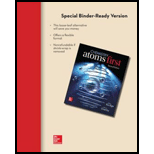
(a)
Interpretation:
Four ionic compounds are given for which chemical formula has to be given with the given clues.
Concept Introduction:
Positively and negatively charged elements are known as ions. Pair of ions forming a compound is specifically named as ionic compounds. Chemical formula is a elemental representation of ratio of ions in the ionic compound.
(b)
Interpretation:
Four ionic compounds are given for which chemical formula has to be given with the given clues.
Concept Introduction:
Positively and negatively charged elements are known as ions. Pair of ions forming a compound is specifically named as ionic compounds. Chemical formula is a elemental representation of ratio of ions in the ionic compound.
(c)
Interpretation:
Four ionic compounds are given for which chemical formula has to be given with the given clues.
Concept Introduction:
Positively and negatively charged elements are known as ions. Pair of ions forming a compound is specifically named as ionic compounds. Chemical formula is a elemental representation of ratio of ions in the ionic compound.
(d)
Interpretation:
Four ionic compounds are given for which chemical formula has to be given with the given clues.
Concept Introduction:
Positively and negatively charged elements are known as ions. Pair of ions forming a compound is specifically named as ionic compounds. Chemical formula is a elemental representation of ratio of ions in the ionic compound.
Want to see the full answer?
Check out a sample textbook solution
Chapter 5 Solutions
Chemistry: Atoms First (Looseleaf)-Package
- The formula of water is If-O. Which of the following is indicated by this formula? Explain your answer. a. The mass of hydrogen is twice that of oxygen in each molecule. b. There are two hydrogen atoms and one oxygen atom per water molecule. c. The mass of oxygen is twice that of hydrogen in each molecule. d. There are two oxygen atoms and one hydrogen atom per water molecule.arrow_forwardWater and sodium chloride are both considered substances as well as compounds, but water exists as molecules while sodium chloride does not. (i) Explain this difference in the behavior of water and sodium chloride. As part of your explanation, (ii) define the terms substance, molecule, and compound.arrow_forwardLead(II) oxide has been added to glass to make a crystal that glistens beautifully. When wine is stored in a crystal decanter, the lead slowly leaches out making lead(II) acetate, which is also known as the sugar of lead. It gives the wine a very sweet flavor but is unfortunately also very toxic. Write the correct chemical formulas for these two compounds.arrow_forward
- Write the formulas for the following compounds:(a) phosphorus pentachloride(b) dinitrogen monoxide(c) iodine heptafluoride(d) carbon tetrachloridearrow_forwardGive the formulas of the compounds in each set: (a) lead(II)oxide and lead(IV) oxide; (b) lithium nitride, lithium nitrite, and lithium nitrate; (c) strontium hydride and strontium hydroxide;(d) magnesium oxide and manganese(II) oxide.arrow_forwardElements in the same group of the periodic table often form oxyanions with the same general formula. The anions are also named in a similar fashion. Based on these observations, suggest a chemical formula or name, as appropriate, for each of the following ions: (a) BrO4 -, (b) SeO3 2-, (c) arsenate ion, (d) hydrogen tellurate ion.arrow_forward
- 88 and 89 pleasearrow_forwardCobalt, a transition metal, forms both the Co2+and Co3+ions. Write the correct formulas and give the name for the oxides formed by the two different ions.arrow_forward(a) What is the formula of carbon disulfi de? (b) What is the name of PCl5? (c) Give the name and formula of the compound whose molecules each consist of two N atoms and four O atoms.arrow_forward
- The element oxygen has three naturally occurring isotopes, with 8,9, and 10 neutrons in the nucleus, respectively. (a) write the full chemical symbols for these three isotopes. (b) Describe the similarities and differences between the three kinds of atoms of oxygen.arrow_forwardPredict the formula and name of a binary compound formed from the following elements: (a) Na and H, (b) B and O, (c) Na and S, (d) Al and F, (e) F and O, (f) Sr and Cl.arrow_forward7. Isotopes. (a) Argon has three naturally occurring isotopes, 36Ar, 38Ar, and 40Ar. What is the mass number of each? How many protons, neutrons, and electrons are present in each? (b) Gallium has two naturally occurring isotopes, 6°Ga (isotopic mass = 68.9256 amu, abundance 60.11%) and 71Ga (isotopic mass = 70.9247 amu, abundance = 39.89%). Calculate the atomic mas of gallium.a %3D (c) Chlorine has two naturally occurring isotopes, 35CI (isotopic mass = 34.9689 amu) and 3"Cl (isotopic mass = 36.9659 amu). If chlorine has an atomic mass of 35.4527 amu, what is the percent abundance of each isotope?arrow_forward
 Chemistry: Principles and ReactionsChemistryISBN:9781305079373Author:William L. Masterton, Cecile N. HurleyPublisher:Cengage Learning
Chemistry: Principles and ReactionsChemistryISBN:9781305079373Author:William L. Masterton, Cecile N. HurleyPublisher:Cengage Learning Chemistry: Principles and PracticeChemistryISBN:9780534420123Author:Daniel L. Reger, Scott R. Goode, David W. Ball, Edward MercerPublisher:Cengage Learning
Chemistry: Principles and PracticeChemistryISBN:9780534420123Author:Daniel L. Reger, Scott R. Goode, David W. Ball, Edward MercerPublisher:Cengage Learning Introductory Chemistry: A FoundationChemistryISBN:9781337399425Author:Steven S. Zumdahl, Donald J. DeCostePublisher:Cengage Learning
Introductory Chemistry: A FoundationChemistryISBN:9781337399425Author:Steven S. Zumdahl, Donald J. DeCostePublisher:Cengage Learning ChemistryChemistryISBN:9781305957404Author:Steven S. Zumdahl, Susan A. Zumdahl, Donald J. DeCostePublisher:Cengage Learning
ChemistryChemistryISBN:9781305957404Author:Steven S. Zumdahl, Susan A. Zumdahl, Donald J. DeCostePublisher:Cengage Learning
 General Chemistry - Standalone book (MindTap Cour...ChemistryISBN:9781305580343Author:Steven D. Gammon, Ebbing, Darrell Ebbing, Steven D., Darrell; Gammon, Darrell Ebbing; Steven D. Gammon, Darrell D.; Gammon, Ebbing; Steven D. Gammon; DarrellPublisher:Cengage Learning
General Chemistry - Standalone book (MindTap Cour...ChemistryISBN:9781305580343Author:Steven D. Gammon, Ebbing, Darrell Ebbing, Steven D., Darrell; Gammon, Darrell Ebbing; Steven D. Gammon, Darrell D.; Gammon, Ebbing; Steven D. Gammon; DarrellPublisher:Cengage Learning





